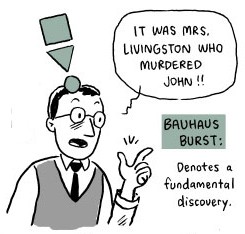
Don't know a grawlix from a plewd or an agitron from an indotherm? Finding words for the marks made by cartoonists is a funny business. A jokey article about the marks cartoonists make for things like movement, emotion and radiation is now the stuff of earnest research into the visual language of cartoons.
It seems to have started with American cartoonist Mort Walker who wrote a satirical article in 1964 called "Let's Get Down to Grawlixes," for the National Cartoonists Society. In 1980 he expanded it to a book The lexicon of comicana. In Mort Walker's Private Scrapbook he writes:
'I spoofed the tricks cartoonists used, like dust clouds when characters are running or lightbulbs over their heads when they get an idea... I spent many hours at the museum recording their "language". I created pseudoscientific names for each cartoon cliché, like the sweat marks cartoon characters radiate. I called them "plewds" after the God of rain "Joe Pluvius".'
The spoof didn't quite work (even though the words he invented are very funny), because people really wanted words for the marks cartoonists make. So here is a run-down, from Wikipedia:
- Plewds Flying sweat droplets that appear around a character's head when working hard or stressed.
- Briffits Clouds of dust that hang in the spot where a swiftly departing character or object was previously standing.
- Squeans Little starbursts or circles that signify intoxication, dizziness, or sickness.
- Emanata Lines drawn around the head to indicate shock or surprise.
- Grawlixes Typographical symbols standing for profanities, which appear in dialogue balloons in the place of actual dialogue.
- Indotherm Wavy, rising lines used to represent steam or heat on hot objects -- however, the same shape found over a hot apple pie or something else strong smelling is a wafteron.
- Agitrons Wiggly lines around an object that is shaking
- Blurgits, swalloops Curved lines preceding or trailing after a character's moving limbs
- Hites Horizontal straight lines trailing after something moving with great speed, or indicating reflectivity (puddle, glass, mirror). Likewise, up-hites would be lines above an object falling.
- Lucaflect A shiny spot on a surface of something
- Dites Diagonal, straight lines drawn across something flat, clear, and reflective, such as windows and mirrors.
- Solrads Radiating lines drawn from something luminous like a lightbulb or the sun.
- Vites Vertical straight lines indicating reflectivity (compare dites, hites)
 It's funny in a Sellars & Yeatman kind of way (something else that deserves to be better known). Dash Shaw responded to the comic challenge with a great cartoon strip using the symbols and The Balloonist drew a booklet for cartoonists using some new symbols. Needless to say, the academically minded take it all very seriously. Neil Cohn just about gets the point. But only just:
It's funny in a Sellars & Yeatman kind of way (something else that deserves to be better known). Dash Shaw responded to the comic challenge with a great cartoon strip using the symbols and The Balloonist drew a booklet for cartoonists using some new symbols. Needless to say, the academically minded take it all very seriously. Neil Cohn just about gets the point. But only just:
'He also attaches a myriad of useless names to them, to the extant that you feel that his whole point for jargon is to be facetious (which it may well have been).'
 See also an explanation of Kirby Dots (developed by Jack Kirby to show an energy explosion) and a site devoted to cataloguing onomatopoeia like 'kaboom' (apparently first used in The incredible hulk, vol 1, no. 229, 1978).
See also an explanation of Kirby Dots (developed by Jack Kirby to show an energy explosion) and a site devoted to cataloguing onomatopoeia like 'kaboom' (apparently first used in The incredible hulk, vol 1, no. 229, 1978).